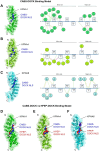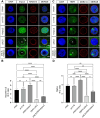Accumulation of TDP-43 causes karyopherin-α4 pathology that characterises amyotrophic lateral sclerosis
- PMID: 40772263
- PMCID: PMC12325296
- DOI: 10.3389/fnins.2025.1558227
Accumulation of TDP-43 causes karyopherin-α4 pathology that characterises amyotrophic lateral sclerosis
Abstract
Cytoplasmic mislocalisation and nuclear depletion of TDP-43 are pathological hallmarks of amyotrophic lateral sclerosis (ALS), including mutations in the C9ORF72 gene that characterise the most common genetic form of ALS (C9ALS). Studies in human cells and animal models have associated cytoplasmic mislocalisation of TDP-43 with abnormalities in nuclear transport receptors, referred to as karyopherins, that mediate the nucleocytoplasmic shuttling of TDP-43. Yet the relationship between karyopherin abnormalities and TDP-43 pathology are unclear. Here we report karyopherin-α4 (KPNA4) pathology in the spinal cord of TDP-43-positive sporadic ALS and C9ALS patients. Structural analyses revealed the selective interaction between KPNA subtypes, especially KPNA4, with the nuclear localisation signal (NLS) of TDP-43. Targeted cytoplasmic mislocalisation and nuclear depletion of TDP-43 caused KPNA4 pathology in human cells. Similar phenotypes were observed in Drosophila whereby cytoplasmic accumulation of the TDP-43 homolog, TBPH, caused the nuclear decrease and cytosolic mislocalisation of the KPNA4 homolog, Importin-α3 (Impα3). In contrast, induced accumulation of Impα3 was not sufficient to cause TBPH mislocalisation. Instead, targeted gain of Impα3 in the presence of accumulating cytosolic TBPH, restored Impα3 localisation and partially rescued nuclear TBPH. These results demonstrate that cytoplasmic accumulation of TDP-43 causes karyopherin pathology that characterises ALS spinal cord. Together with earlier reports, our findings establish KPNA4 abnormalities as a molecular signature of TDP-43 proteinopathies and identify it as a potential therapeutic target to sustain nuclear TDP-43 essential for cellular homeostasis affected in ALS and frontotemporal dementia.
Keywords: C9ORF72; KPNA4; TDP-43; amyotrophic lateral sclerosis; karyopherin; nuclear import.
Copyright © 2025 Atwal, Nimac, Čerček, Goesch, Goesch, Tziortzouda, Ercolani, Zatorska, Pasha, Carre, Mitchell, Troakes, Tummers, Župunski, Rogelj, Hortobágyi and Hirth.
Conflict of interest statement
The authors declare that the research was conducted in the absence of any commercial or financial relationships that could be construed as a potential conflict of interest. The author(s) declared that they were an editorial board member of Frontiers, at the time of submission. This had no impact on the peer review process and the final decision.
Figures




References
-
- Al-Sarraj S., King A., Troakes C., Smith B., Maekawa S., Bodi I., et al. (2011). p62 positive, TDP-43 negative, neuronal cytoplasmic and intranuclear inclusions in the cerebellum and hippocampus define the pathology of C9orf72-linked FTLD and MND/ALS. Acta Neuropathol. 122, 691–702. doi: 10.1007/s00401-011-0911-2, PMID: - DOI - PubMed
-
- Arai T., Hasegawa M., Akiyama H., Ikeda K., Nonaka T., Mori H., et al. (2006). TDP-43 is a component of ubiquitin-positive tau-negative inclusions in frontotemporal lobar degeneration and amyotrophic lateral sclerosis. Biochem. Biophys. Res. Commun. 351, 602–611. doi: 10.1016/j.bbrc.2006.10.093, PMID: - DOI - PubMed
LinkOut - more resources
Full Text Sources
Molecular Biology Databases
Miscellaneous

